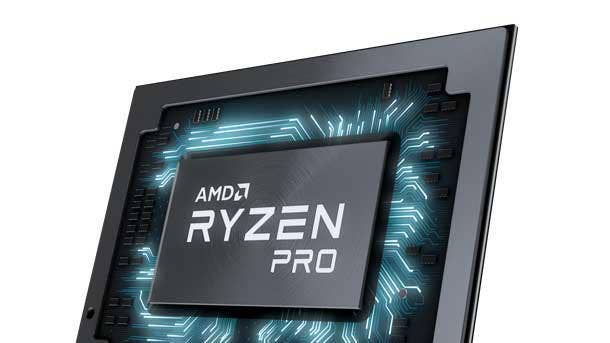How AMD Plans To Win Over Solution Providers For PCs And Servers
AMD exec Jason Mooneyham explains how the chipmaker plans to double funding for solution providers in 2021. ‘Now that we have an expanding portfolio with Dell, HPE and Lenovo on the server side, we can ramp up a lot more of those efforts from a funding standpoint,’ he says.

Funding Technical Positions, Increasing MDF And More
AMD knows it needs to become a bigger channel player if it wants to continue to take market share away from Intel. One way the chipmaker is doing that? Expanding funding for positions inside top solution providers in North America like Insight Enterprise and CDW.
Jason Mooneyham, corporate vice president of Americas sales who oversees AMD’s component and commercial systems channels, told CRN that funded technical positions, which is being doubled next year as part of a big channel blitz, have been the top requested item from national solution providers and value-added resellers because it will help them turn around AMD-based system deals faster.
[Related: Lisa Su’s Channel Awakening: Why Partners Could Be AMD’s ‘Largest Growth Opportunity’]
“As it relates to [distributors] and NSPs, we’re trying to fund those bodies on the floor, so that as those deals come up they’re able to go right in house to get it without having to chase down somebody in our field organization,” he said. “So that’s the goal there: to provide that technical resource on site through funded bodies that are there every day, that are comfortable with the folks inside those walls as opposed to, ‘I’ve never heard of this person before and I’m going to call him right now.’”
In an interview with CRN, Mooneyham, a former Lenovo executive, talked about AMD’s plans to double headcount and funding for commercial systems partners, to what extent the company makes pricing adjustments in competitive bids with Intel, how the company’s volume incentive rebate program works and the other things AMD is doing to win over solution provider companies as partners.

How are AMD’s channel efforts organized?
The good news is we now have multiple groups that are focused on channel. So since last year, our business units themselves, both in server and client, have added resources. They’re focused on this channel effort. As it relates to how we distribute CPUs themselves — in a box for those do-it-yourselfers, for those system builders, whether that be CPU, GPU or motherboard, and those distributors for all those folks around the world, for all those partners — [Corporate Vice President of Global Component Channel Neil] Spicer’s looking after that globally. And then I have an individual in North America and Latin America that run that business for me in those regions.
Now, outside of that, I also have very specific channel coverage, as it relates to the systems — so the [Hewlett Packard Enterprise] and Dell systems that feature EPYC, the Lenovo, the HP that feature Ryzen Pro — in that commercial organization, and they’re talking to many times the same four distributors. So we have dedicated coverage for commercial client systems, let’s say, for Ingram Micro, Tech Data and D&H, in North America, for instance. And then by that same regard when you start talking about the large [national solution providers] like CDW, like Insight, like Connection, like Zones, [we have] dedicated coverage there as well. So we’ve really gone and made sure that those big guys are in place.
When it gets to the [value-added reseller] coverage is where we have been little to none. And my efforts there have been focused on those four distributors and their ability to touch the VARs. I’m going to change that in 2021, as it relates to server VARs, particularly. So we will put dedicated coverage regionally on those top server VARs that are out there as relayed to us by Dell, HPE and Lenovo. So how [the OEMs] approach their top ones will be how we partner with them to go and attack and provide coverage and programs to those VARs as well. So we’ve got an initial call with [World Wide Technology] this week, for instance, on how we want to set up training. But when it comes to the layer below that, [smaller VARS] that aren’t really in that, we’re still going to rely on our co-marketing messaging, our funding, and our big four distributors to do that. [That includes] Arrow as well to the extent that they’re that they’re touching [smaller VARs] on the server side. Federal for us relaunched as a primary focus. There’s a subset of those very large federal [system integrators] that will get coverage as well: the Lockheeds, the Northrops, those types. But again, as a long tail extension of that, as you go down into smaller ones, they will still be covered by the distributor coverage model.

You made a distinction between NSP coverage versus VAR coverage. What is the distinction between those two partner types for AMD?
I think my best answer to give you is: We’ve aligned it to the way that HP and Lenovo take it to market because they are our commercial systems partners. And the way that HPE and Dell approached them as well on the server side, we’ve tried to align our coverage to the way that they view those as either national players versus regional VAR-type players.
For the NSP and VAR coverage, is there a single person that’s in charge of that?
I have a North America commercial leader that that channel organization sits under today. And there’s a channel leader for that. I can just tell you that our primary expansion for [2021], the majority of my headcount — almost all of it honestly — will go into that organization. So that VAR headcount is a 2021 [initiative]. Again, I don’t have single person that touches a VAR today, the way that we would describe it. However, those NSPs that I’ve talked about, every single one of them is covered by someone on a team today. So that’s the difference: I don’t have a growth funding program for VARs yet. That’ll be in ‘21. But every distributor we’ve got covered from multiple fronts, both on that component side and on the system side. And then, all those NSPs are covered for server and client.
When you say you’re adding people for VAR coverage next year, in what organization will that be happening at AMD?
The North America commercial systems channel. We’re talking systems, whether that’s a server system with HPE or Dell, or a client system with Lenovo or HP.
And that is within AMD’s overall sales organization?
Yes, that’s all in the Americas sales organization.
Do they report to you?
Yes, they all report to me.

When you say you’re increasing investments next year, is there any way you can quantify what that will actually look like?
The simplest way to put it for you, where it would jump out for CRN in print, is that we will double our funding from ‘20 to ‘21, which is massive after it’s gone up basically 5x over the last two years. We’ll double it in ‘21. I think that’s the best way to describe it. And because a lot of that is server, when we started the volume incentive rebate program, VIR as we call it, it was completely commercial client system focused. Now that we have an expanding portfolio with Dell, HPE and Lenovo on the server side, we can ramp up a lot more of those efforts from a funding standpoint. So yeah, we will double our funding in 2021, our headcount — this is both AMD-badged [employees] that I’ll have out there in the field that are in our firewall and our funded heads that we would sit inside the likes of these distributors or these NSPs or even VARs, so we will double that as well. The best way I can describe it we will double our headcount and double our funding in ‘21, relative to channel.
When you say double the funding, what would you say that funding is for?
So that funding is being doubled for both the purposes of [market development funds], for funded heads inside those partners walls as well as our volume incentive rebate program. Those very three specific things would be where that funding is targeted.
When we are talking about coverage for NSPs and VARs, what are the kinds of resources they have access to?
So we do a couple things. In the case of server [NSPs and VARs], we can fund technical bodies that can help you know with configurations. But then we also have sprinkled throughout the commercial organization systems engineers that can take a look at the technical requirements of a particular server configuration, for instance, and help out in that way. So, as it relates to [distributors] and NSPs, we’re trying to fund those bodies on the floor, so that as those deals come up they’re able to go right in house to get it without having to chase down somebody in our field organization. So that’s the goal there: to provide that technical resource on site through funded bodies that are there every day, that are comfortable with the folks inside those walls as opposed to, ‘I’ve never heard of this person before and I’m going to call him right now.’ That’s the goal, with solution architects particularly.
And that’s the approach for the NSPs and the VARs?
That’s been the most requested item as we’re talking to that VAR community: ‘give us access to the solution architect.’ So we’ve taken that back and trying to come up with our, our way in our path in ‘21 to make sure you can’t you can’t walk into an organization like WWT and have a sales-focused body. That’s not ideal for them. They’re much more interested in the solution architect, the systems engineer that can help them in a deeply technical configuration and conversation, so we’re going to align ourselves that way.

Can you explain how the volume incentive rebate program works?
We planned this out as an entire year, but obviously with market dynamics shifting as much as they have in 2020, we approach the targets quarterly, very similar to how our OEM counterparts would as well. We’ll go to each of the covered partners to say, ‘here’s what you did a year ago, here’s what you did a quarter ago, [and] here’s what we’re thinking based on a growth target’ that we would both mutually agree to as a target for that quarter — and then there’s a tier-based rebate for the achievement of those targets. We wanted to try to make it very simple. If an AMD-based system on the server side goes out, it counts towards that target. If an AMD-based system on the client side goes out the door to a customer, it goes against that target. And again, we’ve tried to align it to where the growth is very similar to what our OEMs are going in there to say, so it all matches up with what their overall volume program would look like too. So we’re enhancing those programs with our partners, being totally aligned with them, and then helping with co-marketing efforts through MDF to make sure that we’re helping that growth.
For the volume incentive rebate program, is that just for the OEM resellers or does that also include system builders?
It’s just OEM. The incentives on the component channel side are completely unlinked to this whatsoever again. [It’s] run completely separately.
Are there any plans to bring those together the commercial and component channels at some point? Or are you planning to keep them bifurcated?
There’s no plan to bring them together. Let’s just put it that way. And even inside the walls of our distributors, while we are as unified as ever in terms of being one AMD, they still run those businesses very much differently as well. It’s a different executive that I’m talking to [for component and for commercial systems] when I’m talking to them. Until there’s a time where those are intertwined much greater at the partner level, we will continue to run them separately.

I wanted to ask about the annual AMD Partner Summit. How many different partner companies are represented at the event typically? And are you planning to open that up more since it seems like you’re increasing your partner coverage?
I believe we would have had a record turnout probably. We probably had about 2,000 people that wanted to attend. And obviously we had to cancel this year, which is very disappointing. So we’re certainly hoping to bring it back, non-virtual, next year. Off the top of my head, it was around 500 different entities [that would have been represented at the summit], and we’d absolutely like to expand that. The faster our reach into the VAR community — with folks that are well aware of the performance benefits, the customer satisfaction benefits, the efficiency benefits that these AMD-based systems are providing today, and frankly getting to performance leadership was very exciting for us in this space, particularly in the commercial space — it’s a message that we want to have resonating throughout the channel in a very, very big way in ‘21. I’m hoping the interest in Partner Summit and the attendance at Partner Summit continues to grow as well. I do believe that demand will be there, so I’m hoping we can get double the partners on a virtual summit if we have to do it that way, but would expect attendance demand to be very high if we do it live.
A few of the partners talked about how AMD is competing to win competitive bids against Intel. My question is, to what extent does AMD offer price adjustments in competitive bids? And then how much capital has AMD allocated for these situations?
I won’t be able to comment on any capital outlay because I really don’t know the answer. I wouldn’t be able to even give you a guess on that one. Our goal is to be competitive in every bid situation, so I really do look at every one in its own, unique standup fashion, because many of the performance requirements, I believe only AMD can meet in many cases. And so I view competitiveness in a couple of ways: what’s the most competitive solution to bring forward and then, if there is a competitive solution to us, do we need to go and be more competitive on price? So I take all of those as individual situations.
Will we go and make sure we’re competitive? Yes, but I’m also going to look at it from the technical requirements. But we will absolutely value our partners’ opinion in that as well and working with them every step of the way to say, ‘look, we’ve got we’ve got a performance advantage, we’ve a got power consumption advantage, so our overall value proposition here is much better than what’s beside it,’ even though we may be priced the same or we may be priced higher in a certain situation. But we’re going to save them so much money on power, or we’re going to give them so much better performance. We have to take that into account for each individual deal to say, ‘let’s make sure competitive is viewed in more than just price.’
One partner I spoke to talked about how AMD was making pricing adjustments in the face of your competition making its own.
I want the partner community to know that we will look at each individual bid to make sure that we’ve got the most competitive deal, certainly.